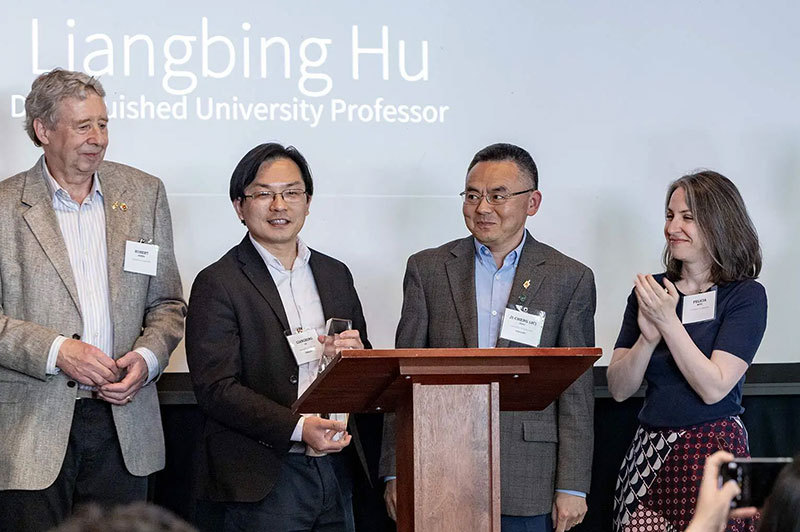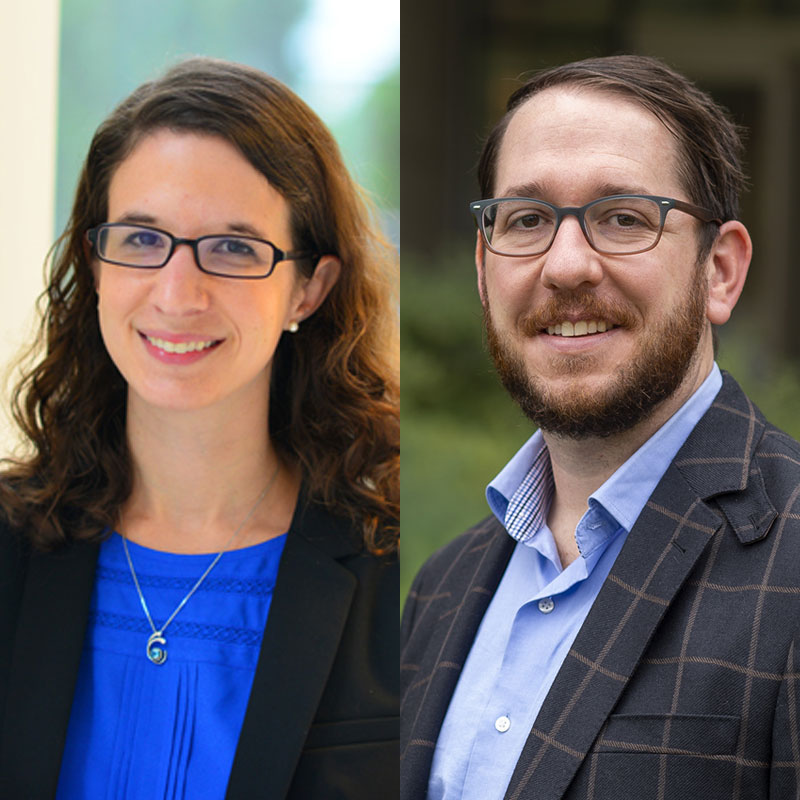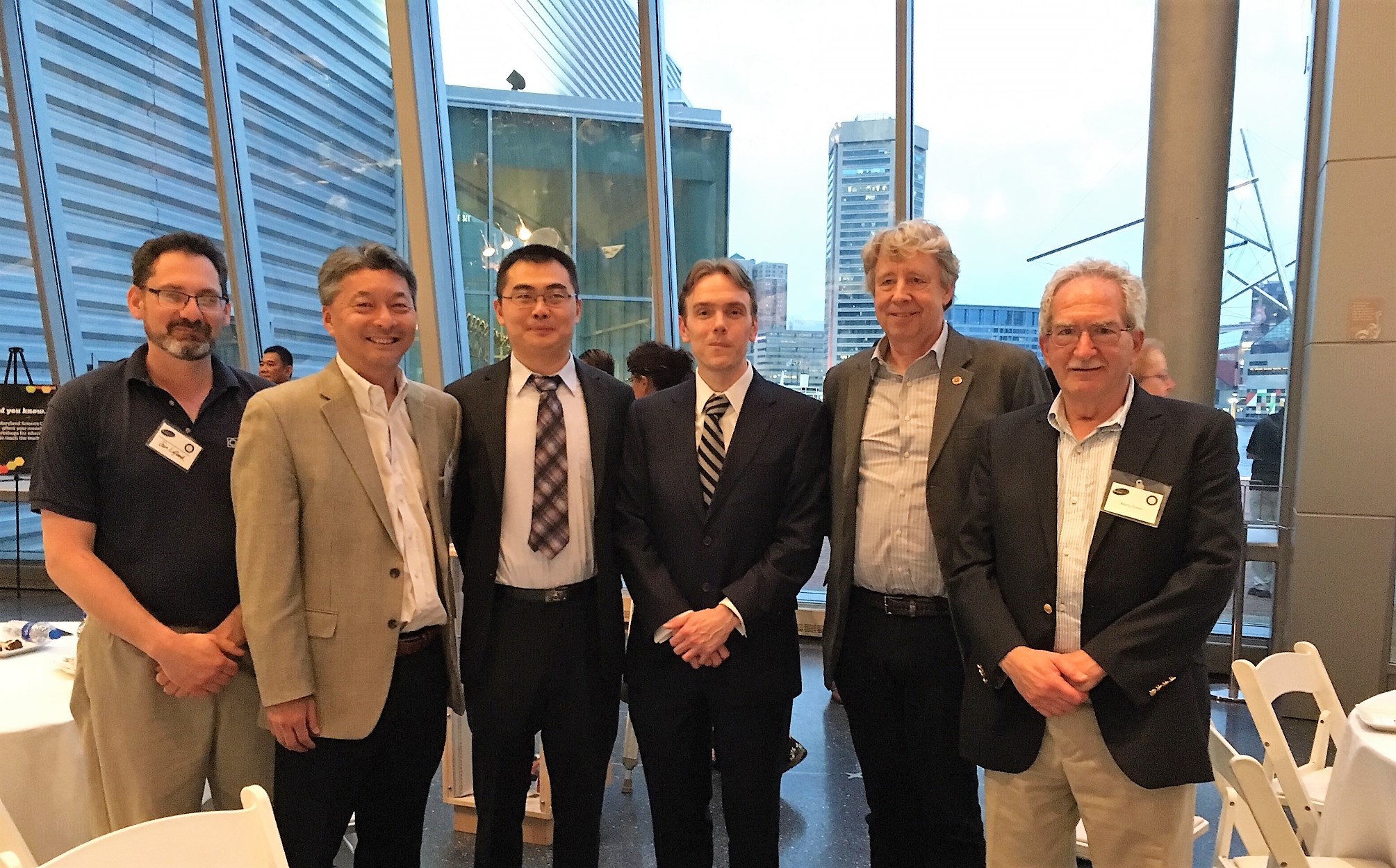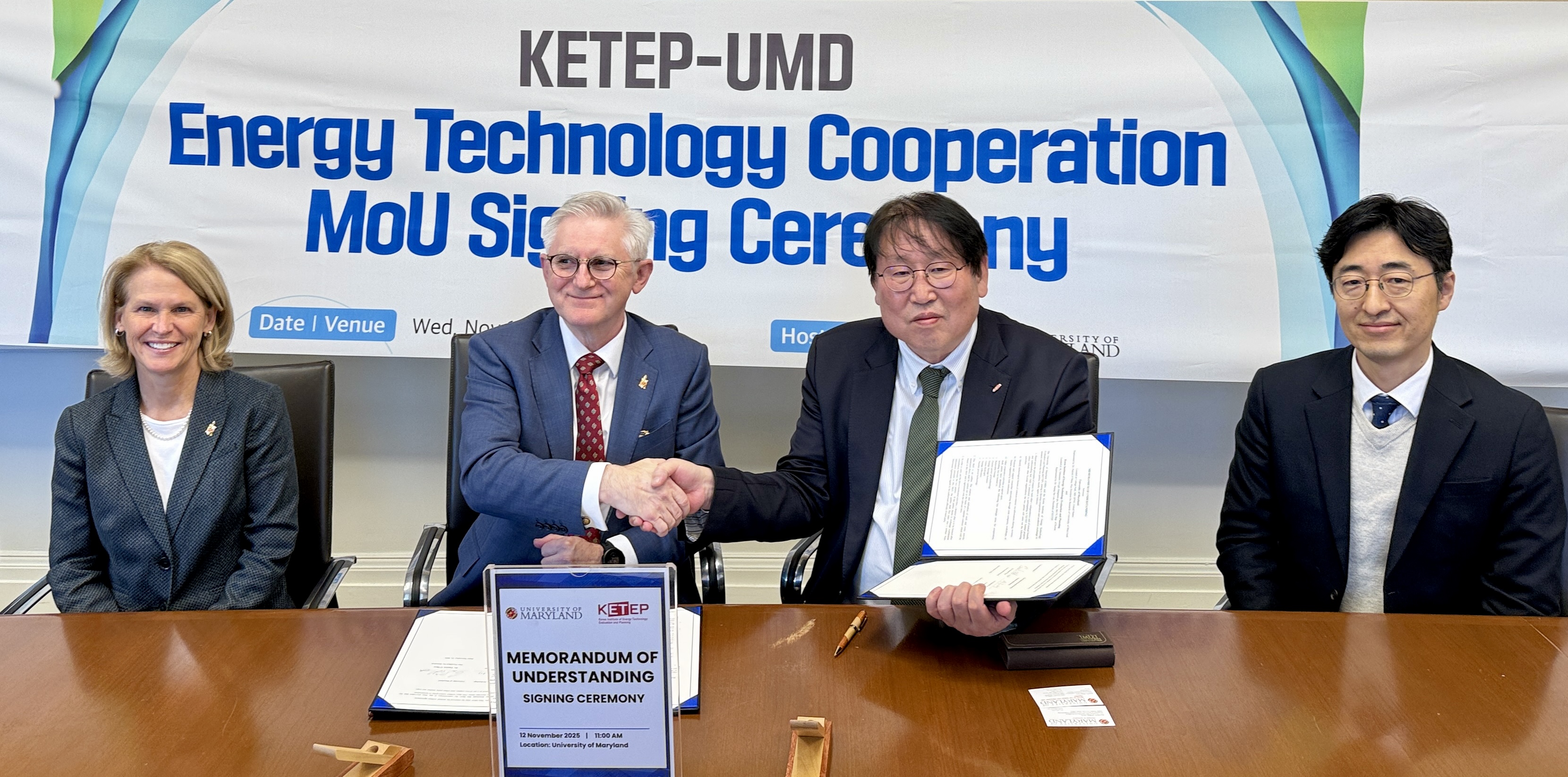News Story
Groundbreaking Plasma Innovation Shines as Invention of the Year

Distinguished University Professor Liangbing Hu (second from left) is honored at the Innovate Maryland Invention of the Year award event. Also pictured (from left), Professor Robert Briber, Department of Materials Science and Engineering Chair Ji-Cheng (JC) Zhao, and UM Ventures Associate Director Felicia Metz. Photo by Stephanie S. Cordle.
In a mesmerizing display, a kaleidoscope of tiny lightning strikes gives way to a brilliant glow hotter than the surface of the sun. While this spectacle may sound like a scene from a sci-fi blockbuster, it’s happening not in a film studio, but in a University of Maryland engineering laboratory.
That miniature lightning is electric arcs passing between two “hairy”-looking blocks made up of carbon fibers; the glow is a plasma that reaches 8,000 degrees Celsius—nearly twice as hot as the highest melting point of any metal. But it isn’t just ultra-hot; it’s also stable enough to revolutionize high-temperature materials engineering. The method took home the top prize on April 29 in the university’s annual Invention of the Year competition.
"Our simple and practical ultra-high temperature plasma technology overcomes the challenges we've seen with producing extreme materials and opens the door to large-scale manufacturing powered by renewable energy, but with low cost and high benefit to the planet,” said Distinguished University Professor Liangbing Hu, the project’s principal investigator.
Along with winners in three other categories, the award was announced as part of Innovate Maryland—an annual celebration of UMD researchers’ creativity in translating cutting-edge research into practical, impactful solutions to address global challenges.
“Each of tonight’s nominees for Invention of the Year started with that spark of an idea that was allowed to grow and evolve with the help of our robust research enterprise, which we all contribute to and improve on a daily basis,” Vice President for Research Gregory F. Ball said of this year’s 12 finalists. “I firmly believe that no grand challenge is too daunting for our world-class researchers to confront head-on and work toward a solution.”
In addition to the Invention of the Year awards, Hu received a special recognition award presented by President Darryll J. Pines. Hu, a professor in the Department of Materials Science and Engineering, has submitted 134 invention disclosures, making him the second-most prolific inventor in the university’s history—a feat he accomplished in only 11 years. He also co-founded the highest number of university IP-based startups, with a record four this fiscal year alone.
Physical Sciences Invention of the Year/Overall Winner: Stable Plasma for Extreme Materials
Department of Materials Science and Engineering researchers Liangbing Hu, Hua Xie, Qian Zhang, and Ji-Cheng Zhao and Princeton University researcher Yiguang Ju developed a new method for creating stable plasma that can be used in extreme materials. The protocol works by applying a voltage between two blocks made of thin carbon fibers. The fibers act as a tip through which electrons can flow, resulting in all the gas between the blocks being turned into a highly stable and ultra high-temperature plasma. The process is simple, scalable, and powered by renewable energy, allowing for reduced cost and a lower carbon footprint to make extreme materials.
Maryland engineers were well-represented among the 2024 Invention of the Year finalists. They included:
Life Sciences Finalist: Localized Drug Delivery from Ingestible Devices
Researchers created an oral capsule that can deliver drugs directly to intestinal tissue. When ingested, it naturally transits the intestinal tract. After reaching a previously identified site of interest, an externally applied magnetic field is used to deploy a cantilever actuator. Drugs are delivered via dissolving microneedles atop the cantilever, and multiple actuators can be integrated per device. In all, these features enable localized drug delivery with higher delivery precision in both longitudinal and polar directions, potentiating site targeting for drug delivery in the GI tract. Inventors include: Joshua Levy (MSE), Michael Straker (BIOE), Reza Ghodssi (ECE/ISR), and Luke A. Beardslee (ISR).
Physical Sciences Finalist: Carbon Sequestering Building Materials
Researchers developed an innovative process for the manufacturing of gradient thermal insulation materials with comparable thermal insulation and mechanical strength to conventional building materials. This process of treating the wheat straw to be processed alongside silica aerogels leads to a cellulose-aerogel gradient thermal insulation material that not only has similar properties to conventional building materials, but the final material can be produced in the form of a slurry with the appropriate shear thinning properties and high storage modulus that allows for additive manufacturing. 3D printed model houses on a lab scale have proven to have sufficient mechanical strength and maintained an internal temperature of 26oC (79oF) when placed in a high-temperature environment of 110oC (230oF) for several hours. Inventors include: Shenqiang Ren (MSE), Arpita Sarkar (MSE), and Long Zhu (MSE).
Quantum Category Finalist: Optical Non-linearity in Ultrathin Semiconductor Device
This invention is directed to a system based on a Van der Waals heterostructure which owns a large nonlinear optical absorption response of Fermi polarons, and is highly tunable by doping and applying an electric field. In most systems, including the ultrathin layered semiconductors, the optical nonlinearity is achieved mainly through the exciton polariton interaction, but such systems lack electrical controllability. Other systems only have nonlinearity behavior at the luminescence regime, which restricts the application in optoelectronics. This invention is able to electrically switch on/off the optical absorptive nonlinearity in the energy regime of 10 meV. It can be used in applications like novel nonlinear optoelectronic devices, e.g., all-optical switches and nonlinear optomechanical resonators. Inventors include: You Zhou (MSE) and Liuxin Gu (MSE).
Quantum Category Finalist: Photonic Integrated Analog-to-Digital Converter
A team of UMD and Northrop Grumman researchers created an analog-to-digital converter exclusively in the optical domain, achieved by exploiting the modulation of thermo-optical materials in carefully designed on-chip photic integrated resonators and circuitry. While there are several digital-to-analog converters, the converse has been elusive. This invention is the missing link in allowing analog photic computing to perform with high efficiency, since its speed and power savings far exceed power hungry traditional analog-to-digital converters. Inventors include: Carlos Rios Ocampo (MSE/IREAP), Niloy Acharjee (ECE/IREAP), and Siddhartha Ghosh (Northrop Grumman).
Adapted from a story by Jordan Dunklee for Maryland Today about all four 2024 Invention of the Year Award winners.
See the complete list of all UMD’s 2024 Invention of the Year finalists.
Published May 2, 2024







